
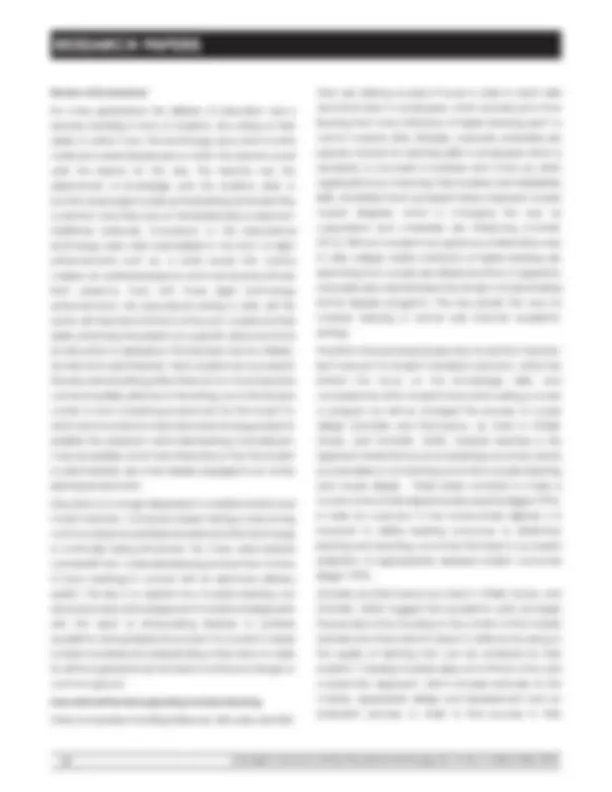
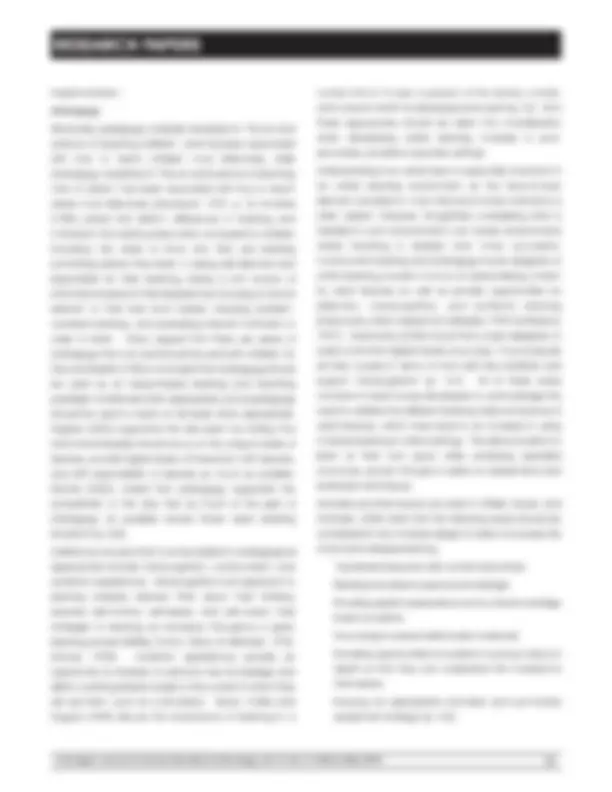
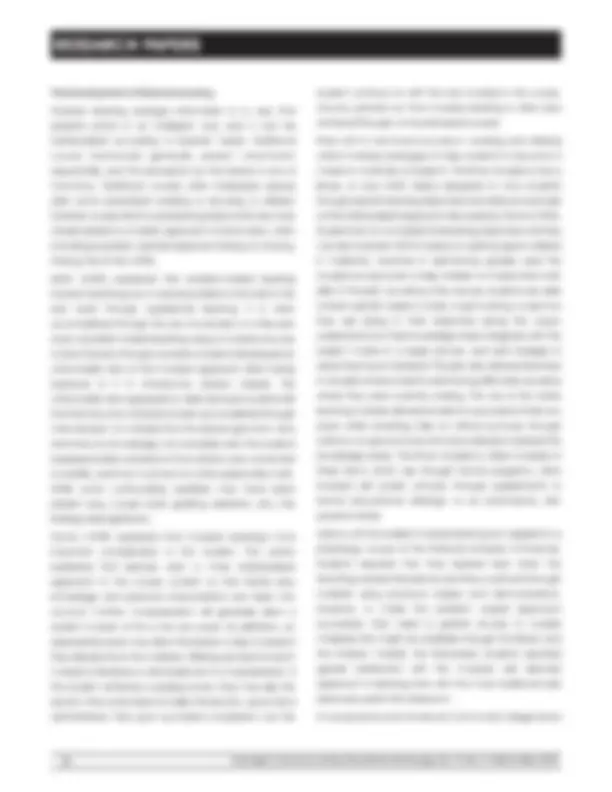
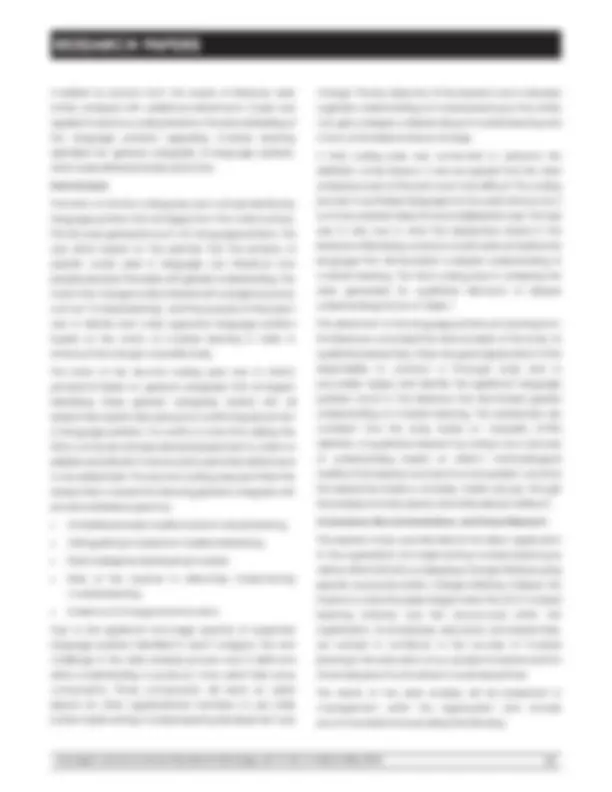
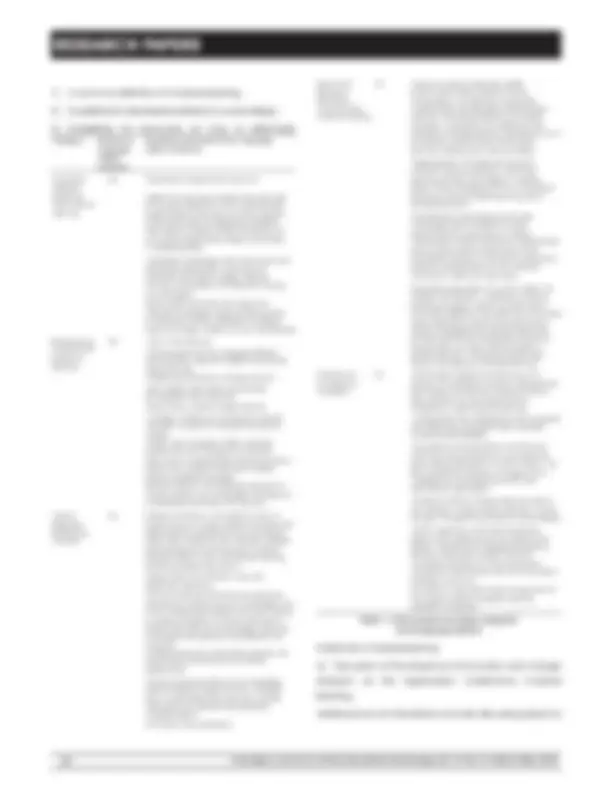
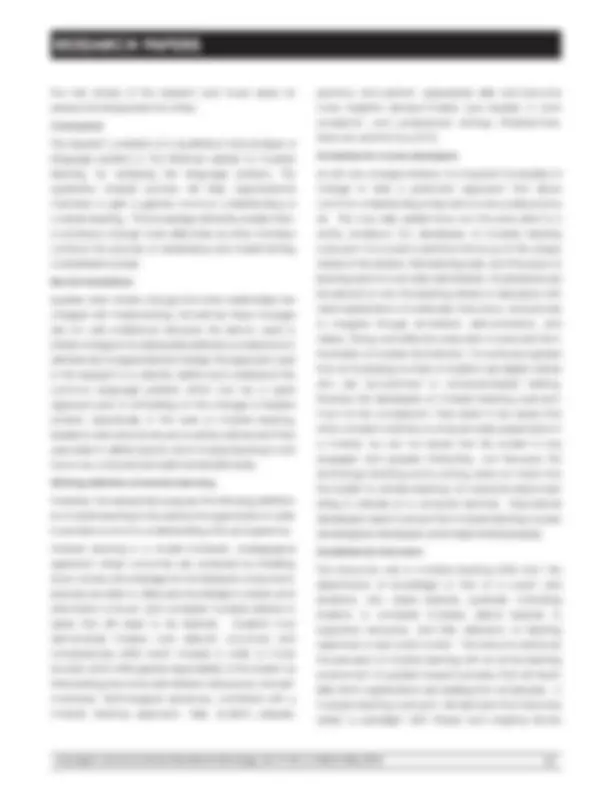
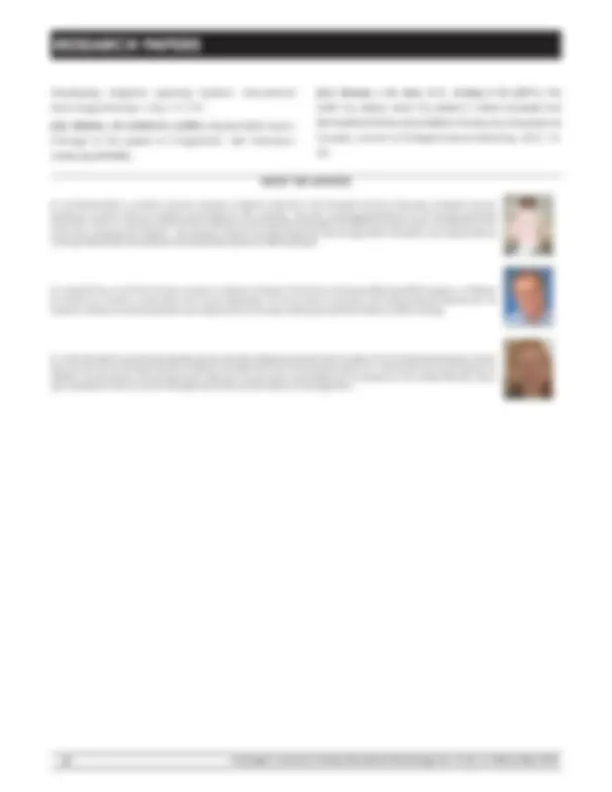


Study with the several resources on Docsity

Earn points by helping other students or get them with a premium plan


Prepare for your exams
Study with the several resources on Docsity

Earn points to download
Earn points by helping other students or get them with a premium plan
Community
Ask the community for help and clear up your study doubts
Discover the best universities in your country according to Docsity users
Free resources
Download our free guides on studying techniques, anxiety management strategies, and thesis advice from Docsity tutors
a course or program; connect outcomes to. student learning and course design; take prior. knowledge and personal characteristics into.
Typology: Study notes
1 / 13

This page cannot be seen from the preview
Don't miss anything!








*_* Kaplan University ABSTRACT_
The purpose of this descriptive paper was to explore and synthesize literature related to understanding modular learning and how it can be implemented effectively so faculty members embrace its use. An in-depth review of literature addressed topics including, Educational Theories supporting modular learning, the development of modular learning, and innovations in education and technology. Researchers analyzed language patterns used in the literature to develop a common language for and understanding of the concept. Analysis and recommendations as well as a proposed definition of modular learning are included.
Keywords: Modular Learning, Organizational Change, Innovation, Online Learning, Technology, Andragogy.
“Change is the only constant in life.” These words spoken by Greek philosopher Heraclitus (535 BCE) still resonate in the minds of people dealing with the forces of change in the 21st century. Change is often initiated with a word or phrase to set the stage of what is to come. Organizational decision-makers often introduce a change initiative with what is commonly called a “buzzword” to start the conversation. Often there is confusion on the meaning of buzzwords or concepts. Leaders of change may assume that everyone has a shared understanding of these words, but often this is a false assumption. For people to effectively embrace a change initiative, it is important to elucidate a deeper understanding of the words that frame the language of change and properly set the stage on which a change initiative is launched.
Using the buzzwords to initiate change is a common organizational problem. Chaudron (2013) succinctly describes the ill effect of “using buzzwords to initiate change as a whip saw effect that causes mass confusion among employees. These buzzwords are often a technique applied with no clear focus as to the why, expected results, or return on investment”. Regardless of the nature of the business, every organization is bombarded with change based on the “word du'jeur.”
Each and every organizational context has its own collection of buzzwords such as just-in-time, total quality, and empowerment. Because using buzzwords to initiate change is a common organizational problem that cuts across industries, this research project should be of interest and value to a wide audience in both the process to define a buzzword as well as how to share information with stakeholders to find higher levels of success in its implementation. One such buzzword being used within an online graduate program is modular learning. While modular learning is at the heart of current change initiatives, currently, there is potential miscommunication among faculty and administrators on the meaning of the concept. It is important to reach a common definition regarding modular learning as the concept is being implemented. In a larger context, researchers believe it is a worthy endeavor to investigate the thinking that underlies any term or phrase that is used to initiate and frame change. The intent of this paper is to develop a greater understanding of the concept of modular learning as it applies to an online university seeking to improve and expand the learning process, and also to provide take-away lessons that can be applied in other change of initiatives. Further, the intent of this paper is to emphasize the importance of creating a
shared, a common understanding of modular learning as a means for organizational members to better embrace the dynamics of change by reviewing the literature.
The context for this change initiative is an online university, specifically a graduate business program. Academic and corporate leaders of this institution are seeking to optimize educational opportunities by modularizing the current academic curriculum. The aim is to improve the delivery of current academic courses for greater student success as well as supply employers with future employees who possess specific skills and knowledge required in various industries. The university hopes to reach out to prospective business-to-business partners who value in connecting with the online university to deliver professional training and development for their employees.
Statement of the Problem
Often organizational change movements are initiated with a “buzzword”. The leader who begins a change process may have his or her own definition and ideas behind the buzzword, but it is unlikely that others share that knowledge and may have a different interpretation of what the word(s) mean. Simply, there is not common understanding of the buzzword terms. When this happens, it does not bode well for others to embrace the change effectively. This paper will help to counter that issue by developing a strategic plan to elucidate supportive language patterns found in the literature so that greater common understanding is increased and embracing change is enhanced.
Seeking language patterns to embrace change
The patterns of specific words can influence how individuals perceive a change. A single term or buzzword used to initiate change may be perceived to be universally understood, but often this is not the case. For example, the full meaning of the buzzword “improving leadership” is impossible to convey and understand if this is how a leadership change initiative being is introduced. The people who will be charged with developing and implementing “improved leadership” may be asking questions like: What type of leadership?. Servant leadership? Transformational leadership? Situational leadership? Leadership according to whom? Popular authors and speakers? Corporate gurus? Academic
writers? Military authorities? Historical figures? Religious figures, etc. What is missing is a common understanding of the history, philosophy, and development on the concept of leadership. Unless the notion of leadership is supported with an investigation of the supportive language patterns found in thorough a review of the literature, then the likelihood of embracing this change initiative is doomed to flounder. Gergen (1994) made significant contributions to the value and influence of language by seeking answers to the question of how people know what people know. Gergen contended that people create meaning together and so the idea of language becomes the creator of reality. Watkins & Mohr (2001) developed the Appreciative Inquiry (AI) approach that is based on the nature of how humans think and create language patterns that positively impact how people work together. This human interaction and relationship is created through the influence of language. Alexander(1979) suggested that, “The source of life which you create lies in the power of the language which you have”. The power of language creating social architecture and organizing people to work together for a common purpose is a lesson that directs the focus of this research endeavor. Based on this premise, it is a worthy endeavor for this project to take the first step. The research process begins with a review and examination of the literature to build a supportive structure of language patterns from noted authorities. It is through these insights that a common understanding of modular learning will be created, thereby increasing the opportunity for employees to more fully embrace and implement the change initiative. The purpose of this study was to research best practices and definitions of modular learning and analyze the literature to determine language patterns that exist within it. Objectives included creating a common definition for modular learning to be shared with all stakeholders, providing recommendations on how results can be applied as instructors implement modular learning and increasing effectiveness of its use, and to offer suggestions for future research.
implementation.
Andragogy
Historically, pedagogy, is literally translated to “the art and science of teaching children”, and has been associated with how to teach children most effectively, while andragogy, translated to “the art and science of teaching men or adults”, has been associated with how to teach adults most effectively (Davenport, 1987, p. 5). Knowles (1980) stated that distinct differences in learning and motivation that adults posses when compared to children including: the need to know why they are learning something before they learn it, being self-directed and responsible for their learning, being a rich source of information based on their experiences, focusing on what is relevant to their lives and careers, enjoying problem- centered learning, and possessing internal motivation in order to learn. Many argued that there are areas of andragogy that can and should be used with children. So Day and Baskett (1982) concluded that andragogy should be used as an inquiry-based learning and teaching paradigm at all levels when appropriate, just as pedagogy should be used to teach at all levels when appropriate. Hughes (2002) supported the discussion by stating that instructional leaders should focus on the unique needs of learners, provide higher levels of interaction with learners, and shift responsibility to learners as much as possible. Rachel (2002), stated that androgogy supported the sympathetic to the view that as much of the spirit of andragogy as possible should infuse adult learning situations” (p. 224).
Additional concepts that must be added to andragogical approaches include metacognition, constructivism, and authentic experiences. Metacognition is an approach to learning whereby learners think about their thinking. Learners self-monitor, self-assess, and self-correct their strategies to learning as necessary throughout a given learning process (Ridley, Schutz, Glanz, & Weinstein, 1992; Schraw, 1998). Authentic experiences provide an opportunity for learners to practice new knowledge and skills in a setting related closely to the context in which they will use them, such as a simulation. Brown, Collins and Duguid (1989) discuss the importance of learning in a
context that is “in part, a product of the activity, context, and culture in which it is developed and used” (p. 32). All of these approaches should be taken into consideration when developing online learning modules in post- secondary, as well as corporate, settings. Understanding how adults learn is especially important in an online learning environment as the face-to-face element provided in most brick-and-mortar institutions is often absent. However, thoughtfully considering what is needed in such environments can create environments where learning is deeper and more successful. Constructivist learning and andragogy forces designers of online learning courses to focus on personalizing content for adult learners as well as provide opportunities for reflection, metacognition, and authentic learning (Dobrovolny, 2006; Merriam & Caffarella, 1999; Sutherland, 1997). Dobrovolny (2006) found that course designers, in order to find the highest levels of success, “must evaluate all their courses in terms of how well they facilitate and support metacognition” (p. 167). All of these areas combine to lead course developers to acknowledge the need to address the different learning styles and paces of adult learners, which have lead to an increase in using modular learning in online settings. This allows students to learn at their own pace while achieving specified outcomes, proven through a variety of assessments and evaluation techniques. Donnelly and Fitzmaurice (as cited in O'Neill, Moore, and McMullin, 2005) state that the following areas should be considered in any modular design in order to increase the chances for deeper learning: “Sustained interaction with content and others; Relating new ideas to previous knowledge; Providing explicit explanations and a clear knowledge base to students; Structuring in a reasonable student workload; Providing opportunities for students to pursue topics in depth so that they can understand the material for themselves; Ensuring an appropriate formative and summative assessment strategy” (p. 102).
The Development of Modular Learning
Modular learning arranges information in a way that presents points in an intelligent way, and it can be individualized according to learners' needs. Traditional course frameworks generally present information sequentially, and the perception by the learner is one of monotony. Traditional courses often intersperse quizzes after some prescribed reading or lecturing is offered. Modular courses tend to use learning objects that are more closely related to a holistic approach to information, often including a problem oriented approach (Tseng, Su, Hwang, Hwang, Tsai, & Tsai, 2008).
Sahin (2009) explained that problem-based learning involves teaching how to resolve problems that exist in the real world through experiential learning. It is often accomplished through the use of scenarios. In a Peruvian study of problem based learning using a modular structure to teach physics through scenarios, students developed an unfavorable view of the modular approach after having exposure to it in introductory physics classes. The unfavorable view appeared to arise because students felt that the instruction of physics is best accomplished through memorization of material that the learner gets from texts and instructor knowledge. Any favorable view the students expressed solely centered on how physics was connected to real life, and how it connects to other subjects like math. While some confounding variables may have been present (e.g. course load, grading variations, etc.) the findings were significant.
Dochy (1989) explained that modular learning's most important consideration is the student. The author explained that learners want a more individualized approach to the course content so that his/her prior knowledge and personal characteristics are taken into account. Further, modularization will generally allow a student to learn at his or her own pace. By definition, an appropriate pace may allow the learner to skip modules if they already know the material. Offering pre-tests for each module is therefore a critical element to modularization. If the student achieves a passing score, they may skip the section. If he or she does not taken the section, a post test is administered. Only upon successful completion can the
student continue on with the next module in the course. Douchy pointed out that modular learning is often best achieved through computer based courses. Khan (2011) has found success in creating and offering online modular packages to help students to become a master in multitude of subjects. The Khan Academy has a library of over 4300 videos designed to tutor students through specific learning objectives and offers an example of the individualized approach discussed by Dochy (1989). Students do not complete the learning objectives until they can demonstrate 100% mastery. In a pilot program offered in California, teachers in elementary grades used the Academy's resources to help children to master their math skills. In the pilot, as well as other venues, students are able to learn specific subject matter, to get tutoring, to see how they are doing in their objectives along the way,to understand how their knowledge base integrates with the subject matter in a larger picture, and earn badges in areas they have mastered. The pilot also allowed teachers to visualize where students were having difficulties as well as where they were currently working. The use of the online learning modules allowed students to proceed at their own pace while receiving help at critical junctures through online or on-ground tutors who have already mastered the knowledge areas. The Khan Academy offers modules in three forms which are through formal programs, often involved with public schools; through supplements to formal educational offerings; or as stand-alone, self- paced tutorials. Gahutu (2010) studied modular learning as it applied to a physiology course at the National University of Rwanda. Students reported that they learned best when the teaching was less theoretical, and they could work through material using practical classes and demonstrations. However, to make the problem based approach successfull, they need a greater access to outside materials that might be available through the library and the Internet. Overall, the Rawandan students reported greater satisfaction with the modular, self directed approach to learning than with the more traditional style previously used in the classroom. In a study done at an American Community College and a
Computer-Based Training (CBT) was nothing more that programmed instruction that simply is the identified steps to follow in standard procedures. Currently CBT has become more individualized allowing the learner to work through the learning material at their own pace. The technology in delivering computer-based training improved in concert with a better understanding of how people learn.
Not everyone learns best sitting in solitude at a computer terminal. Understandably there is high value in being present in a classroom with an instructor presenting concepts, responding to questions, and nurturing the learning process. In the late 1990s a term was coined to address this concern of computer-based training. The result was a concept which is called as blended learning. A blend of the best elements found in a traditional brick and mortar classroom (brick) coupled with the best elements found in e-learning (click). The blended learning environment of brick and click capitalized on the best of both educational delivery methods (McSporran & King, 2005; Sitzman & Ely, 2009).
Research Methodology
Meta-Analysis
The purpose of meta-analysis is to allow the researcher to make a significant contribution to knowledge and understanding (Schreiber, Crooks, & Stern, 1997). The approach of this research study is to utilize a qualitative meta-analysis methodology with the purpose to make a contribution to the knowledge and understanding of modular learning. This type of approach is based on a systematic process for synthesizing and summarizing the results advanced by other. Developing a thorough review of literature and content analysis on modular learning advances the investigation on the statement of the problem. According to Singleton & Straits (1990) a meta- analysis methodology is appropriate to uncover insights from previous work and studies. Utilizing this methodological approach will add value to understanding the concept of modularization in this research study.
Data collection in meta-analysis uses multiple and complementary information in exploring the body of literature. This is accomplished by investigating the body of literature on modular learning from three different aspects.
The three aspects are given by, ·Educational theories and concept supporting Modular Learning. ·The Development of Modular Learning. ·Innovations in education and technology. This approach is designed to expand the review of literature beyond the phrase of modular learning to other relevant, related, and supportive subjects. Data evaluation in meta- analysis is conducted by coding responses or insights that strengthen understanding of modular learning. Coding and identification of stronger language patterns from the review of literature is enhanced by utilizing NVivo, (qualitative data analysis computer software) produced by QSR International, to assist the evaluation of the data. Coding through NVivo The first step was to conduct a thorough review of the literature to expose a greater understanding of the breadth and depth of modular learning. Once this general informational data was gathered, the researchers conducted a more refined coding of language patterns to add greater support and clarity to the understanding of modular learning. Managing qualitative data generated from numerous insights by recognized authors in the literature begins with a meticulous and rigorous process to explore and discover significant themes and language patterns to strengthen a deeper understanding of modular learning. It is worthy to note that the coding process is iterative. Proficiency in coding is central to conducting qualitative analysis. The researchers are proficient in coding qualitative data and have demonstrated competency in other published research papers. The researchers remain cognizant and adhere to proper open proper coding procedure as set by Singleton and Straits (1999), and Creswell (1998). Initial open coding permitted an unrestricted coding approach during the initial pass through the literature review section. Subsequent passes were made and the review of literature was read and recorded in order to expose more detail and clarity to the emerging themes in the language patterns related to modular learning. Codes
modified as sections from the review of literature were further analyzed with additional refinements made and applied to previous coding iterations. Provisional labeling of the language patterns regarding modular learning identified ten general categories of language patterns, which were refined and reduced to five.
Data Analysis
The intent on the first coding pass was to simply identify key language patterns that emerged from the noted authors. This first pass generated such 412 language patterns. This was done based on the premise that the patterns of specific words used in language can influence how people perceive the reality with greater understanding. The notion that change is often initiated with a single buzzword, such as “modular learning”, and the purpose of this project was to identify and code supportive language patterns based on the notion of modular learning in order to embrace the change more effectively.
The intent of the second coding pass was to attach provisional labels on general categories that emerged. Identifying these general categories started with all researchers openly discussing and confirming placement of language patterns. It is worthy to note that utilizing the NVivo computer software allowed researchers to code in a reliable and efficient manner which permitted refinements to be added later. The second coding pass permitted the researchers to reveal the following general categories with provisional labels as given by,
·Similarities between traditional and modular learning.
·Distinguishing modular from traditional learning.
·Role of designers developing modules.
·Role of the teacher in effectively implementing modular learning.
·Evidence of change and innovation.
Due to the significant and large quantity of supportive language patterns identified in each category, the next challenge in the data analysis process was to distill and refine understanding to produce more useful take away components. Those components will serve as useful lessons for other organizational members to use while further implementing modular learning development and
change. The key objective of this research was to develop a greater understanding of modular learning so that others can gain a deeper understanding of modular learning and more comfortably embrace change. A third coding pass was conducted to advance the distillation of key lessons. It was recognized that the data analysis process at this point was more difficult. The coding process to synthesize language into focused and succinct summary patterns takes time and deliberate care. The task was to stay true to what the researchers stated in the literature while being conscious to articulate and refine the language that will elucidate a deeper understanding of modular learning. The third coding pass in analyzing the data generated for qualitative elements of deeper understanding is shown in Table 1. This refinement of the language patterns emanating from the literature concluded the data analysis of this study. As qualitative researchers, there was great appreciation of the responsibility to construct a thorough study and to accurately assess and identify the significant language patterns found in the literature that illuminated greater understanding of modular learning. The researchers are confident that this study builds on Creswell's (1998) definition of qualitative research by noting it as a “process of understanding based on distinct methodological traditions that explore a social or human problem, and that the researcher builds a complex, holistic picture, through the analysis of words, reports, and other relevant artifacts”. Conclusions, Recommendations, and Future Research This research study was intended for the direct application to the organization for implementing modular learning as well as other institutions undergoing change initiatives using specific buzzwords and/or change initiatives. Indeed, the impetus to write this paper began when the 2013 modular learning initiative was first announced within the organization. As employees, educators, and researchers, we wanted to contribute to the success of modular learning in the education of our academic learners and for the employees of our business-to-business partners. The results of the data analysis will be presented to management within the organization and include recommendations for providing the following:
the next phase of this research and future areas for research and exploration for others.
Conclusions
This research consisted of a qualitative meta-analysis of language patterns in the literature related to modular learning, by analyzing the language patterns. This qualitative analysis process will help organizational members to gain a greater common understanding of modular learning. This knowledge will better enable them to embrace change more effectively as other members continue the process of developing and implementing modularized courses.
Recommendations
Leaders often initiate change that other stakeholders are charged with implementing. Sometimes these changes are not well understood because the lexicon used to initiate change is not adequately defined or understood. In all instances of organizational change, the approach used in this research is to identify, define and understand the common language patterns which can be a useful approach prior to embarking on the changes of leaders envision. Specifically, in the case of modular learning, leaders in educational venues would be well served if they were able to define exactly what modular learning is and how it can, or should, be implemented effectively.
Working definition of modular learning
Therefore, the researchers propose the following definition for modular learning to be used by the organization in order to provide a common understanding of its use as given by,
Modular learning is a student-centered, andragogical approach where outcomes are achieved by breaking down a body of knowledge into its individual components. Learners are able to utilize prior knowledge to assess what information is known and complete modules related to areas that still need to be learned. Students must demonstrate mastery over relevant outcomes and competencies within each module in order to move forward, which shifts greater responsibility to the student as their learning becomes self-initiated, self-paced, and self- monitored. Technological advances, combined with a modular learning approach, help students prepare,
practice, and perform appropriate skills and become more insightful decision-makers and leaders in both academic and professional settings (Friestad-Tate, Hancock, and McCoy, 2013). Guidelines for course developers As with any change initiative, it is important for leaders of change to take a systematic approach that allows common understanding of key terms to be understood by all. This may take added time, but the extra effort is a worthy endeavor. For developers of modular learning curriculum it is crucial to reinforce the focus on the unique needs of the learner, their learning style, and the pace of learning which is most often self-initiated. Emphasis should be placed on why the learning needs to take place with clear explanations of workloads, instructions, and process to navigate through simulations, demonstrations, and videos. Strong and effective education is executed from the inside, not outside, the institution. It must be recognized that an increasing number of students are digital natives who are accustomed to computer-based training. However the developers of modular learning curriculum must not be complacent. They need to be aware that when a student watches a computer video presentation in a module, we can not assure that the student is truly engaged and properly interacting. Just because the technology teaching tool is running, does not mean that the student is actively learning; not everyone learns best sitting in solitude at a computer terminal. Educational developers need to ensure that modular learning courses are designed, developed, and implemented properly. Guidelines for instructors The instructor's role in modular learning shifts from the disseminator of knowledge to that of a coach and facilitator, who assists learners, positively motivating students to complete modules, directs learners to supportive resources, and links relevancy of learning objectives to real world context. The instructor reinforces the precepts of modular learning with an active learning environment of problem-based scenarios that will teach skills which organizations are seeking from employees. A modular learning curriculum will demand that instructors adopt a paradigm shift. Proper and ongoing faculty
development must be in place as it is crucial that instructors should be successful educators for modular learning to be successful for students.
Change and innovation
A leader may initiate change, but it is the responsibility of organizational stakeholders to implement change processes over time. There is high value in taking a step back to investigate the literature and exposing a deeper understanding of the buzzwords leaders use to initiate change, as that increases the ability to embrace organizational change more effectively.
While there is an acceptance in the use of technology, which has paved the way for modular learning, it is important to note that modular learning can be successful using any delivery method. Modular learning can serve as an effective tool in an online educational setting as a means to help students most effectively utilize their time and knowledge toward achieving goals.
Modular learning has been in practice for many decades, but at this moment there exists an incredible opportunity to the remarkable learning process with the power of exploding technological innovation. As educators and researchers in a leading online university, educators are poised to offer contributions to the next “Gutenberg” or “printing press” moment in education, which captures the dramatic way human thinking produces a revolutionary movement. The original “Gutenberg moment”, which took hundreds of years, created the mass production of books, lower unit cost, democratized ownership of knowledge, and assured consistency and quality in transferring knowledge. Today, the innovation and impact of change has accelerated exponentially. Modular learning coupled with technological innovations of the 21^ st century may produce the next “printing press” moment.
Future Research
While this study is a first step, it is important to continue investigating research related to defining modular learning, examining effective organizational change, and exploring connections between modular learning and flipped instruction which would be worthwhile endeavors. A next step would be to examine how modular learning is currently being developed within the organization and to
identify the alignment of language patterns being developed in new modular curriculum with those discovered in this meta-analysis study. References [1]. Alexander, C. (1979). The timeless way of building. New York: Oxford University Press. [2].Biggs, J. (1999). Teaching for Quality Learning at University. Buckingham: SRHE/OU Press. [3]. Brown, J. S., Collins, A., & Duguid, P. (1989). Situated cognition and the culture of learning. Educational Researcher , 32–42. [4]. Chaudron, D. (2013). Begin at the beginning in organizational change. Organizational Change Consultancy. Retrieved on July 15, 2013 from: http://www.organizedchange.com/nmdb/index.htm [5]. Connell, C. (2013). Starbucks, Wal-Mart offering classes for college credit. Retrieved on April 15, 2013 from: http://www.kcci.com/news/project-economy/Starbucks- Wa l - M a r t - o f f e r i n g - c l a s s e s - f o r - c o l l e g e - c r e d i t / - /9356884/19750390/-/item/0/-/wapxgl/-/index.html. [6]. Creswell, J. W. (1998). Qualitative inquiry and research design: Choosing among 5 traditions. Thousand Oaks, CA: SAGE Publications. [7]. Cross, K. (1998). Classroom Research: Implementing the Scholarship of Teaching. New Directions For Teaching And Learning , (75), 5-12. [8]. Davenport, J. (1987). A way out of the andragogy morass. Lifelong Learning: An Omnibus of Practice , 11 (3), 17-21. [9]. Dobrovolny, J. (2006). How adults learn from self- paced, technology-based corporate training: New focus for learners, new focus for designers. Distance Education , 27(2), 155-170. DOI 10.1080/01587910600789506. [10]. Dochy F, Open Univ. H, (2013). And O. Modularization and Student Learning in Modular Instruction in Relation with Prior Knowledge. [serial online]. January 1, 1989;Available from: ERIC, Ipswich, MA. Accessed May 14, [11]. Friestad-Tate, J., Hancock, C., McCoy, C. (2013). Understanding modular learning – Developing a strategic plan to embrace change. Paper presented at the Institute
Developing Adaptive Learning Systems. Educational Technology & Society, 11(2), 171-191.
[32]. Watkins, J.M. & Mohr, B.J. (2001). Appreciative inquiry: Change at the speed of imagination. San Francisco: Jossey-Bass/Pfeiffer.
[33]. Wenner, J. M., Burn, H. E., & Baer, E. M. (2011). The Math You Need, when You Need It: Online Modules that Remediate Mathematical Skills in Introductory Geoscience Courses. Journal of College Science Teaching , 41(1), 16-
ABOUT THE AUTHORS
Dr. Jill Friestad-Tate is currently a faculty member of Kaplan University in the Graduate School of Business. At Kaplan she has served as a mentor and on multiple committees for the university. She has a working experience in K-12 through graduate education. She is a member of the Institute of Behavioral and Applied Management (IBAM) and Association of Supervision and Curriculum Development (ASCD). Her research interest includes Leadership, Technology Skills of Students, And Organizational Change Utilizing Both Quantitative and Qualitative Research Methodologies.
Dr. Craig McCoy is a full time faculty member for Kaplan University in the School of Business MBA and MSM programs. At Kaplan he serves as a mentor, course lead, and course developer. He has 23 years of business and entrepreneurial experience. His research interest includes Leadership and Organizational Change, Utilizing a Qualitative Research Methodology.
Dr. Carol Schubert is a full time graduate faculty member at Kaplan University and an adjunct for Cumberland University. Carol is also an instructor for Entrepreneurship at Kaplan's Professional and Continuing Education arm. She serves as a faculty advisor for DREAM, Faculty Senator, Faculty Revolution Member, Course Lead, and Professional Competency Committee Member. She is also a reviewer for the Journal of Management History and Academy of Management.